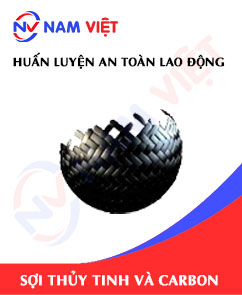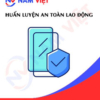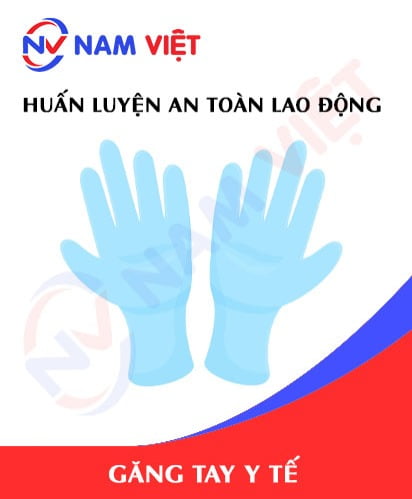Occupational Safety Training for Glass Fiber and Carbon Fiber Production
99,000 ₫
Note: The above price is calculated for one person. Prices may vary depending on the number of trainees participating in the course and market fluctuations. For more accurate pricing support, please refer to the pricing table or contact our consulting staff directly.
Occupational safety is an important issue in fiberglass and carbon fiber manufacturing factories and needs to be addressed promptly to ensure the health and safety of workers as well as enhance the reputation of businesses. The Occupational Safety Training course is one of the effective solutions to raise awareness of accident prevention for workers participating in fiberglass and carbon fiber production.
Table of Contents
Toggle1. Overview of Fiberglass and Carbon Fiber
a. What are Fiberglass and Carbon Fiber?
Fiberglass and carbon fiber are types of fibers used in various industries.
Fiberglass is a fiber made from molten glass. The production process of fiberglass starts by melting glass, then feeding it into a fiber drawing machine to create long fibers. Fiberglass has relatively high mechanical strength, can withstand high temperatures, and is corrosion-resistant. It is commonly used in insulation, fireproofing, mechanical, construction, and electronics industries.
Carbon fiber, also called carbon fiber, is a fiber made from carbon. The production process starts with extracting carbon from raw materials such as polyacrylonitrile (PAN) fibers, activated carbon, or cellulose. The carbon is then heated at high temperatures in air or other gases to form carbon fibers. Carbon fiber has superior mechanical properties, high stiffness, high mechanical strength, heat resistance, corrosion resistance, and good electrical conductivity. It is widely used in medical, aerospace, automotive, sports, and high-tech applications such as carbon composite production.
Both fiberglass and carbon fiber have distinct properties and applications, used across different industrial fields depending on specific application requirements.

b. Types of Machinery for Fiberglass and Carbon Fiber Production
The machinery for fiberglass and carbon fiber production may vary depending on the production process and technology used. Below are some common machines used in fiberglass and carbon fiber production:
- Fiber drawing machine: Used to draw and process raw materials into long fibers. The drawing process for glass and carbon differs in some aspects, but the general principle is to feed the material through required temperature and pressure to create continuous fibers.
- Glass processing machine: For fiberglass, the production process typically involves softening the raw glass material and using processing machines to draw and create fibers.
- Carbon fiber processing machine: Carbon fiber production can use various technologies such as PAN-based carbon fiber, activated carbon fiber, or cellulose-based carbon fiber. Each technology has its own processing procedure, which may include ovens, fiber drawing machines, soaking machines, or winding machines.
- Oven and carbonization: In carbon fiber production, ovens are used to heat raw materials (such as PAN) through specific temperature stages and environments to carbonize and create carbon fibers.
- Soaking or winding machine: After obtaining carbon fibers, soaking or winding machines are used to create final products such as carbon fabric or carbon fibers for composite production.

c. Fiberglass and Carbon Fiber Manufacturers in Vietnam
Below are some fiberglass and carbon fiber manufacturers in Vietnam:
- Fiberglass:
- Saigon Fiber Glass (SFG): SFG is a leading fiberglass manufacturer in Vietnam, supplying fibers for industries such as construction, automotive, electronics, and insulation.
- Minh Duc Fiber Glass: Minh Duc Fiber Glass is also a top fiberglass manufacturer in Vietnam, producing and supplying fibers for insulation, fireproofing, construction, and electronics applications.
- Carbon Fiber:
- Tong Son Carbon Fiber (TSCF): TSCF is a leading carbon fiber manufacturer in Vietnam, specializing in supplying carbon fibers and products for industries including aerospace, automotive, and high technology.
- Phu Lam Composite (PLC): PLC specializes in carbon fiber and carbon composite production in Vietnam, providing carbon fiber, composite materials, and products for automotive, bicycle, aerospace, and medical applications.
- Minh Viet Composite (MVC): MVC is a manufacturer of carbon fiber and carbon composites based in Vietnam, providing carbon fiber, Kevlar fibers, and composite products for industries requiring lightness and high durability.
Note that this list includes only typical companies and does not cover all fiberglass and carbon fiber manufacturers in Vietnam. Other companies may exist and operate in this sector.

d. Specific Jobs in Fiberglass and Carbon Fiber Factories
Group 1
- CEO, deputy CEO, department heads in fiberglass and carbon fiber factories.
Group 2
- Safety officer: managing safety in the factory, designing safety procedures, monitoring and ensuring employees follow safe working practices.
Group 3
- Material preparation: Handling raw materials: For fiberglass, this includes heating and softening raw glass. For carbon fiber, materials like PAN or activated carbon are prepared by forming initial fibers or pre-processing to remove impurities.
- Fiber drawing process: Fiber drawing machines: Fiberglass and carbon fibers are drawn through machines to create long, continuous fibers. This requires adjusting temperature, pressure, and drawing speed to achieve desired fiber dimensions and properties.
- Carbonization (for carbon fibers): Carbon ovens: Materials like PAN are heated at high temperatures in air or other environments to form carbon fibers. This process requires controlling temperature, duration, and atmosphere.
- Fiber processing and finishing: Soaking or winding: After producing fiberglass or carbon fiber, the next step may include soaking or winding to create final products such as fabric, carbon composites, or other products depending on application requirements.
Group 4
- Office work, service, sales, marketing.
- Production management, quality management, human resources, material management, financial accounting.
- Research and development of new products, packaging design.
2. Overview of Occupational Safety Training for Fiberglass and Carbon Fiber Production
In this article, we focus on issues related to Group 3, because Group 3 directly participates in production and faces the highest occupational safety risks. For reference on other groups click here.
a. What is Group 3 Occupational Safety Training?
- Group 3 Occupational Safety Training consists of classes that provide awareness and prevention methods for workplace accidents to employees.
- The safety training course helps workers recognize and prevent hazards, reducing risks of workplace accidents during operations.
REGISTER FOR OCCUPATIONAL SAFETY TRAINING SERVICE
b. Training Duration
Initial safety training duration
- Total training time is at least 24 hours, including testing time.
- 8 hours theory on occupational safety laws and policies
- 8 hours theory on basic occupational safety knowledge
- 4 hours theory on specialized training content
- 2 hours practical on specialized content
- 2 hours final theory test
The training center arranges the schedule into multiple sessions depending on employee availability. Typically, there are 6 sessions, completed in 3 days if the company allows continuous learning time.
Periodic safety training duration
- Before the occupational safety card expires, employees must undergo periodic occupational safety training, with duration at least 50% of the initial training duration.
Explanation: total periodic occupational safety training duration is at least 12 hours, including testing. After completing periodic training and passing the test, employees are reissued or extended their occupational safety cards.
c. Training Content
| No. | TRAINING CONTENT | TRAINING TIME (HOURS) | |||
| Total | Including | ||||
| Theory | Practical | Test | |||
| I | Occupational safety laws and policies system | 8 | 8 | 0 | 0 |
| 1 | Overview of legal documents on occupational safety and hygiene. | 6 | 6 | ||
| 2 | System of standards, technical regulations on occupational safety and hygiene. | 1 | 1 | ||
| 3 | Specific regulations from state management agencies regarding occupational safety when constructing, expanding, or renovating production facilities and handling equipment and materials requiring strict safety and hygiene. | 1 | 1 | ||
| II | Basic knowledge of occupational safety and hygiene | 8 | 8 | 0 | 0 |
| 1 | Basic knowledge of hazards and harmful factors at the workplace. | 4 | 4 | ||
| 2 | Methods to improve working conditions. | 1 | 1 | ||
| 3 | Safety culture in production and business. | 1 | 1 | ||
| 4 | Rights and duties of employers and employees; occupational safety policies; functions of safety officers. | 1 | 1 | ||
| 5 | Occupational safety rules, signs, and use of safety equipment; first aid skills and occupational disease prevention. | 1 | 1 | ||
| III | Specialized training content | 6 | 4 | 2 | 0 |
| Knowledge about machines, equipment, hazardous substances; risk analysis and management; safe work procedures for equipment and materials requiring strict occupational safety. | 6 | 4 | 2 | ||
| IV | Final test of occupational safety training | 2 | 2 | 0 | 0 |
| Total | 24 | 22 | 2 | ||
See more training content of 6 groups
d. Occupational Safety Card
After completing occupational safety training and passing the test, employees will be issued an occupational safety card (commonly called Group 3 safety certificate).
The card shows information such as full name, date of birth, job, work environment, training duration, red stamp, and signature confirming completion.
According to Article 24 of Decree 44/2016/ND-CP, there are two cases:
- If there is a labor contract between employer and employee, the employer must stamp and endorse the safety card for the trained Group 3 employee after completing training and passing the test.
- If the worker is freelance or temporary without a labor contract, the training unit must stamp and endorse the card after training and testing.

3. Identifying Hazards Affecting Workers in Fiberglass and Carbon Fiber Production
Fiberglass and carbon fiber production may involve several hazards that affect workers. Below are some main hazards that workers may encounter:
- Exposure to fiberglass materials: Fiberglass can cause damage to the skin and eyes if not properly protected. Direct contact with fiberglass may cause skin irritation, eye inflammation, and respiratory issues.
- Exposure to carbon materials: The processing and production of carbon fiber may involve the use of chemical compounds such as epoxy or carbonized compounds. Exposure to these substances can cause skin irritation, respiratory problems, and potentially harm health if not properly controlled.
- Fiberglass and carbon fiber dust: The production process may generate fine fiber dust, which can irritate the respiratory system and cause health problems if inhaled. Carbon fiber dust may be hygroscopic and dirty if not properly managed.
- Chemical fumes: Carbon fiber production may involve chemicals such as solvents, cleaners, or other chemical agents. Fumes from these substances can irritate the respiratory system and nervous system if safety and ventilation are not properly managed.
- High temperature: The baking and carbonization process in carbon fiber production involves high temperatures, which can be dangerous for workers without protective measures such as heat-resistant clothing, proper protective equipment, and safety management.
- Electrical heat: Some machinery and equipment in fiberglass and carbon fiber production can generate electrical heat, which is hazardous if not properly controlled and protected.

4. Common Workplace Accidents in Fiberglass and Carbon Fiber Production
During fiberglass and carbon fiber production, workers may encounter various types of workplace accidents. Below are some common accidents:
- Cuts to hands or fingers, or wounds from cutting tools during material preparation or fiber processing.
- Injuries from collisions with machinery, equipment, or components during production.
- Chemical poisoning from materials used in production, such as solvents, epoxy compounds, or cleaners.
- Skin, eye, or respiratory irritation from exposure to chemical compounds.
- Fire and explosion risks from chemicals, plastics, or toxic gases during production.
- Burn risks from exposure to high temperatures or heating equipment.
- Inhalation of fiberglass or carbon fiber dust may cause respiratory irritation, pneumonia, or other health problems.
- Contact with fiberglass can irritate the skin, eyes, or connective tissues.
- Risks from transporting heavy or bulky materials and equipment.
- Accidents from lifting heavy items, such as fiberglass or carbon fiber rolls.
5. Safety Measures in Fiberglass and Carbon Fiber Production
When participating in fiberglass and carbon fiber production, adhering to safety measures is crucial to protect health and ensure worker safety. Some important safety measures include:
- Eyes: Use safety goggles or dust masks to protect the eyes from direct contact with fiberglass or carbon fiber and to prevent damage from dust, chemicals, or other agents.
- Skin: Ensure the use of protective clothing, gloves, and safety shoes to protect the skin from direct contact with fiberglass, carbon fiber, or materials that may cause irritation or other health issues.
- Respiratory: Use masks or protective respirators to prevent inhalation of fiber dust, toxic fumes, or chemical substances present during production.
- Hand hygiene: Ensure frequent handwashing and use of disinfectants to prevent the spread of bacteria and other harmful agents.
- Dust management: Ensure working in an environment with an effective dust extraction system and proper cleaning to minimize the risk of inhaling fiberglass or carbon fiber dust.
- Safety training: Provide comprehensive occupational safety training for all employees involved in fiberglass and carbon fiber production. Training includes safety rules, work procedures, use of personal protective equipment, and hazard prevention measures.
- Regular workplace environmental monitoring in factories, collecting and analyzing harmful factors to adjust and reduce hazards, preventing occupational diseases.
6. Benefits of Occupational Safety Training for Fiberglass and Carbon Fiber Production
An Toan Nam Viet provides businesses with the following benefits after completing occupational safety training courses in accordance with Decree 44/2016/ND – CP on occupational safety and hygiene:
- Workers can recognize potential hazards of workplace accidents and take preventive measures to avoid them.
- Businesses can establish risk prevention measures in production, operation, and maintenance processes.
- Reduce costs associated with potential safety incidents.
- Continuous production ensures increased labor productivity and product quality.
- Compliance with occupational safety laws and regulations, reducing legal risks.
- Enhances reputation and professionalism, elevating the business brand.
Nam Viet’s training courses are a solution to prevent external hazards, helping individuals avoid injuries or even fatalities.
REGISTER FOR OCCUPATIONAL SAFETY TRAINING
7. Customer Feedback After Completing Fiberglass and Carbon Fiber Safety Training
An Toan Nam Viet has many years of experience supporting businesses in Vietnam, especially in the southern provinces. This responsibility is extremely valuable to Nam Viet, so occupational safety training is always conducted professionally. The growth of An Toan Nam Viet comes from positive feedback and suggestions from businesses. Below are feedbacks from partners we have served.
See more customer interviews after using services from An Toan Nam Viet
8. An Toan Nam Viet’s Occupational Safety Training Capacity
An Toan Nam Viet is a reputable and quality occupational safety training center in Vietnam. Training sessions are conducted continuously at factories, production workshops, or construction sites across all 63 provinces.
REGISTER FOR OCCUPATIONAL SAFETY TRAINING
Occupational Safety Training License
- An Toan Nam Viet has been inspected and certified by the Department of Labor Safety under MOLISA, confirming eligibility for occupational safety and hygiene training. This strengthens our training capacity.

Materials and Lectures
- Before inclusion in safety training courses, materials are reviewed to ensure accuracy and effectiveness.
- Teaching methods of instructors follow An Toan Nam Viet standards, designed by experts in occupational safety and hygiene training for optimal knowledge transfer.
Facilities
- Controlling classroom conditions enhances teaching efficiency and learner knowledge absorption.
- Training support facilities are spacious and meet standards for area, lighting, and training equipment.
9. Nationwide Reputable Occupational Safety Training Center
At An Toan Nam Viet, occupational safety training is our top priority. We aim to equip workers with self-protection knowledge, contributing to national development.
We prepare meticulously, from tools, teaching equipment, curricula, documents, sound, and lighting.
Our instructors are experienced specialists with research on hazards in all professions and preventive measures. Lectures are practical and engaging, aligned with Decree 44/2016/ND-CP.
Our training center proudly provides professional, reputable occupational safety training with advantages such as:
- Competitive costs while maintaining training quality.
- Flexible training schedules for business operations.
- Fast and legal certification process.
- Experienced instructors.
- Classroom conditions optimized for teaching efficiency and knowledge absorption.
- Curricula tailored to occupational safety in businesses.
- Dedicated and professional service for accurate support.

10. Additional Reference Materials for Fiberglass and Carbon Fiber Safety Training
- Occupational Safety Training Materials
- Fiberglass and Carbon Fiber Safety Materials
- Occupational Safety Training Test
- Fiberglass and Carbon Fiber Safety Training Curriculum
- Fiberglass and Carbon Fiber Safety Multiple Choice Test
1 review for Occupational Safety Training for Glass Fiber and Carbon Fiber Production
No comments yet















namchinh.haiphong341
Dịch vụ huấn luyện an toàn lao động rất tốt nhé, giảng viên dạy rất sinh động dễ hiểu!